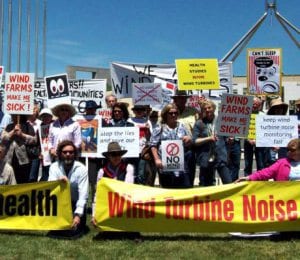Over the last few years the rollout of wind farms in Australia has faced some setbacks, yet the sector’s fortunes are changing.
In 2011 Victoria’s Coalition government imposed onerous restrictions on wind farms, which stalled the sector’s development and cost thousands of jobs and billions in investment in that state.
More recently on a national level, Senators Madigan and Xenophon have pushed similarly restrictive legislation in the Senate and the Coalition’s reluctance to support the 41,000 GWh Renewable Energy Target is creating uncertainty for developers.
The impact of these policy issues have been amplified by a noisy minority of anti-wind farm campaigners. The Waubra Foundation and website, Stop These Things, among others, have attempted to turn the public against clean, renewable energy generated from the wind.
Taking a chapter out of the climate deniers playbook, they consistently raise doubts about the technology. The anti-wind lobby repeatedly claim wind farms cause 233 health problems despite 19 reviews showing wind energy to be clean and safe.
While the anti-wind farm campaign has bought into its own rhetoric, the Australian public hasn’t. Poll after poll shows the majority of Australians support more wind farms. These people come from all walks of life – blue-collar workers who see the jobs potential of the sector; farmers who want to drought-proof their land by hosting turbines; and environmentally conscious community members who want to be a part of climate change solutions.
For a time, it was difficult for this silent majority to have their views heard.
Over the last decade climate change campaigns have focused on big-picture policy items such as the Renewable Energy Target and carbon pricing. While succeeding in having the key pillars of its agenda implemented, climate change advocates didn’t adequately engage with communities about the very projects the policies would encourage. Anti-wind campaigners filled this vacuum unchallenged for a time, but not anymore.
Yes 2 Renewables and the recently-formed Victorian Wind Alliance are helping this silent majority of wind farm supporters stand up. The broad alliance between farmers, wind workers and environmentalists that VicWind has assembled resembles the winning formula of Lock the Gate.
Working together, pro-wind voices have turned the tide in the ‘wind wars’. Momentum has shifted from the anti- to pro-wind side over the last 12 months.
In late 2012, anti-wind activists rolled out the usual scare campaign against the Cherry Tree Rage wind farm proposal in Trawool, Victoria. Councilors rejected a planning permit even though the shire’s own department recommended the project for approval. Yes 2 Renewables worked with the local BEAM-Mitchell Environment Group to fight back against the anti-wind energy scare campaign, preparing and distributing 10,000 ‘mythbusting’ flyers to set the record straight. The community group performed a watchdog role in VCAT hearings and is fired up for round two.
The political landscape for wind energy changes along with the premier in Victoria. Unlike Premier Ted Baillieu, whose opposition to wind farms was driven by personal distaste and suspected concerns for family interests, wind power has benefited Dr Napthine more than any other politician in the state. Two-thirds of the Victoria’s wind turbines are located in the Premier’s electorate and including 60 turbine tower manufacturing jobs at Keppel Prince in Portland. The Victorian Wind Alliance and local wind workers organised joint statement urging Dr Napthine to create jobs and dump Baillieu’s anti-wind farm laws.
The highest profile wind farm proposal in Australia is on King Island, where TasWind is seeking community support for a 200 turbine, 600MW wind farm. The political activity surrounding the proposal led Giles Parkinson to describe it as “a battle of will and influence between the anti- and pro-wind campaigners. The implications for the wind industry generally could be significant.” The project scraped through with a majority voting for a feasibility study. Yes 2 Renewables played positive role in the debate, holding the activists to account for their anti-wind spin and travelling to King Island to observe community forums.
Duelling rallies in Canberra last June was undoubtedly the highpoint of the wind wars. Anti-wind farm hate site Stop These Things kicked the mother of all own goals by calling a national ‘wind power fraud’ rally at Parliament House. Despite the hype, support from shock jock Alan Jones and well-connected organisers, the rally attracted a measly 100 people. A few kilometres away in Canberra, at Yes 2 Renewables and GetUp!’s Rally 4 Renewables, a much larger crowd of 1000 showed their support for wind farms and the RET.
While the anti-wind farm movement is down, it’s not out. Restrictive wind farm laws remain in place in Victoria and could be adopted elsewhere. It’ll take sustained effort engaging communities to secure a future for Australia’s clean, wind energy sector. The Victorian Wind Alliance and Friends of the Earth’s Yes 2 Renewables campaign are up for the challenge.
Friends of the Earth is a member of Vic Wind, an alliance of community members, farmers, workers and environment groups who support wind energy.










